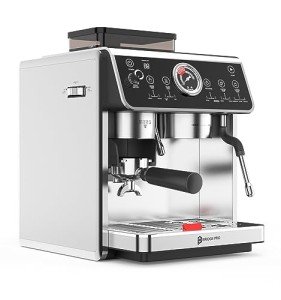Home Use Espresso Machines Isn't As Tough As You Think
Home Use Espresso Machines: A Comprehensive Guide
Espresso machines have become a staple in many families as coffee lovers seek to duplicate café-quality brews in the comfort of their cooking areas. The rise in popularity has actually resulted in a diverse market filled with various designs, features, and rates. This article intends to supply a useful introduction of home use espresso machines, helping readers navigate their choices efficiently.
Understanding Espresso Machines
Espresso machines work by requiring warm water through finely-ground coffee under high pressure, resulting in a focused coffee beverage called espresso. There are several types of espresso machines categorized based upon their developing approaches and level of automation. The most typical types consist of:
Manual Espresso Machines: These require the user to control the pressure and water flow, enabling a more hands-on coffee-making experience.
Semi-Automatic Espresso Machines: These offer automatic control over water pressure, while the user manually grinds and tamps the coffee.
Automatic Espresso Machines: With the push of a button, these machines immediately manage the flow of water, making it much easier to brew espresso with constant outcomes.
Super- Automatic Espresso Machines : These all-in-one machines manage grinding, tampering, brewing, and even milk frothing, making them perfect for users trying to find convenience.
Capsule or Pod Machines: These use pre-packaged coffee pods to create espresso with minimal effort, but they limit option in developing strategies and tastes.
Table: Comparison of Espresso Machine Types
Type
Control Level
Reduce of Use
Cleaning Level
Suitable For
Manual
User-controlled
Moderate
High
Coffee purists
Semi-Automatic
Partial automation
Moderate
Moderate
Home baristas
Automatic
Fully automated
Easy
Low
Busy individuals
Super-Automatic
Totally automated
Very easy
Very low
Convenience candidates
Capsule/Pod
Fully automated
Very easy
Very low
Casual drinkers
Secret Features to Consider
When selecting a home use espresso machine, it's vital to consider various functions that can considerably affect the quality of espresso and user experience.
Pressure: Look for machines that provide at least 9 bars of pressure, as this is considered ideal for developing espresso.
Boiler Systems: Single vs. dual boiler systems figure out temperature stability and the capability to brew espresso and steam milk at the same time.
Grinder: Integrated mills enable for freshly ground coffee, which boosts taste. Think about machines with adjustable grind settings.
Milk Frother: For those who enjoy coffees and lattes, an integrated steam wand or automatic frother is essential.
Size and Design: Consider your kitchen space and visual preferences. Machines are available in different sizes, from compact to large setups.
Rate: Home espresso machines can range from a few hundred to numerous thousand dollars, so it's crucial to establish a budget before checking out alternatives.
Pros and Cons of Home Use Espresso Machines
Pros
Cons
Convenience of developing coffee in the house
Initial investment can be high
Quality of espresso is frequently superior
Needs some skill, specifically with manual machines
Capability to explore flavors
Upkeep and cleaning can be labor-intensive
Can save cash in the long run
Not all machines will suit every coffee choice
Maintenance and Cleaning Tips
Preserving an espresso machine is vital for extending its life and guaranteeing consistent brew quality. Here are some useful tips:
Regular Descaling: Minerals from water can build up in the machine. Descale every 1-3 months, depending on water firmness.
Daily Cleaning: Rinse portafilters, baskets, and steam wands after each use to prevent coffee oils from constructing residue.
Use Filtered Water: This can help in reducing mineral buildup and enhance the taste of coffee.
Change Gaskets and Seals: These components may wear in time and must be replaced to preserve pressure and performance.
Check out the Manual: Each machine has particular care instructions; following these will guarantee durability.
Frequently Asked Questions About Home Use Espresso Machines
**Q1: What is the very best budget espresso machine?The best budget espresso machine typically depends on private needs, but models like the DeLonghi EC155 or the Breville Bambino are popular amongst users for offering terrific value. Q2: How long do home espresso machines normally last?With appropriate upkeep, home espresso machines can last anywhere from 5 to 15 years, depending upon the quality of the machine and frequency of use. Q3: Can I make coffees and lattes with any espresso machine?While most espresso machines can make coffees and lattes, having a reputable
steam wand or frother is vital for accomplishing the best milk texture.
Q4: Are super-automatic machines worth the investment?For those who focus on benefit and quick developing, super-automatic machines can be worth the financial investment, though they might lack some customizability in brew strength and flavor. Q5: What kinds of coffee beans are best for espresso?While personal preference contributes, beans labeled as” espresso “blends are typically roasted darker, creating rich flavors and a velvety texture when brewed.
Buying a home espresso machine can change the daily coffee regimen into something special, raising home brews to café quality. By comprehending the various kinds of machines, key features to think about, upkeep needs, and weighing the
benefits and drawbacks, customers can make educated choices that suit their specific choices. As the espresso culture continues to grow, no matter the choice, every brew can be a tasty experience waiting to be appreciated.  **
**